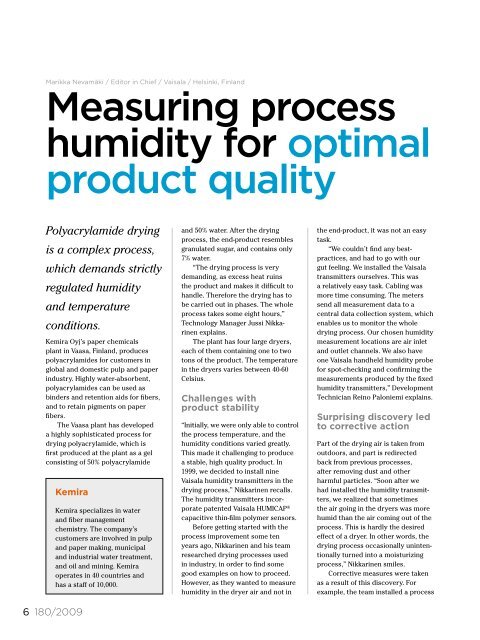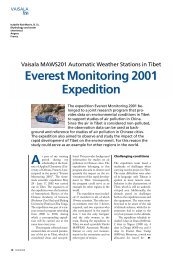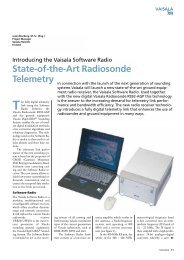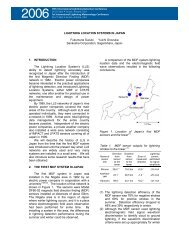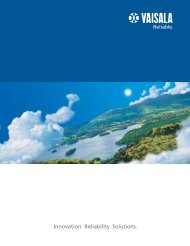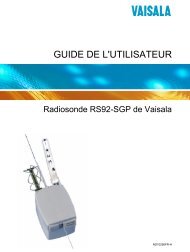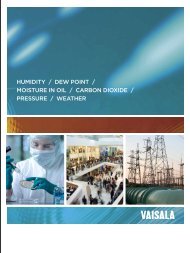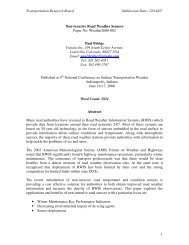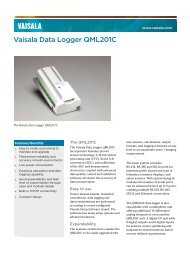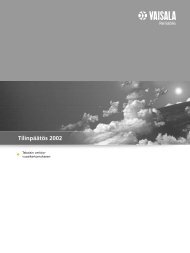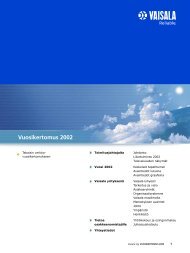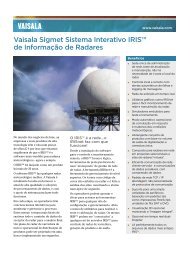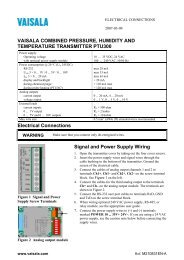Measuring process humidity for optimal product quality - Vaisala
Measuring process humidity for optimal product quality - Vaisala
Measuring process humidity for optimal product quality - Vaisala
Create successful ePaper yourself
Turn your PDF publications into a flip-book with our unique Google optimized e-Paper software.
Marikka Nevamäki / Editor in Chief / <strong>Vaisala</strong> / Helsinki, Finland<br />
<strong>Measuring</strong> <strong>process</strong><br />
<strong>humidity</strong> <strong>for</strong> <strong>optimal</strong><br />
<strong>product</strong> <strong>quality</strong><br />
Polyacrylamide drying<br />
is a complex <strong>process</strong>,<br />
which demands strictly<br />
regulated <strong>humidity</strong><br />
and temperature<br />
conditions.<br />
Kemira Oyj’s paper chemicals<br />
plant in Vaasa, Finland, produces<br />
polyacrylamides <strong>for</strong> customers in<br />
global and domestic pulp and paper<br />
industry. Highly water-absorbent,<br />
polyacrylamides can be used as<br />
binders and retention aids <strong>for</strong> fibers,<br />
and to retain pigments on paper<br />
fibers.<br />
The Vaasa plant has developed<br />
a highly sophisticated <strong>process</strong> <strong>for</strong><br />
drying polyacrylamide, which is<br />
first produced at the plant as a gel<br />
consisting of 50% polyacrylamide<br />
Kemira<br />
6 180/2009<br />
Kemira specializes in water<br />
and fiber management<br />
chemistry. The company’s<br />
customers are involved in pulp<br />
and paper making, municipal<br />
and industrial water treatment,<br />
and oil and mining. Kemira<br />
operates in 40 countries and<br />
has a staff of 10,000.<br />
and 50% water. After the drying<br />
<strong>process</strong>, the end-<strong>product</strong> resembles<br />
granulated sugar, and contains only<br />
7% water.<br />
“The drying <strong>process</strong> is very<br />
demanding, as excess heat ruins<br />
the <strong>product</strong> and makes it difficult to<br />
handle. There<strong>for</strong>e the drying has to<br />
be carried out in phases. The whole<br />
<strong>process</strong> takes some eight hours,”<br />
Technology Manager Jussi Nikkarinen<br />
explains.<br />
The plant has four large dryers,<br />
each of them containing one to two<br />
tons of the <strong>product</strong>. The temperature<br />
in the dryers varies between 40-60<br />
Celsius.<br />
Challenges with<br />
<strong>product</strong> stability<br />
“Initially, we were only able to control<br />
the <strong>process</strong> temperature, and the<br />
<strong>humidity</strong> conditions varied greatly.<br />
This made it challenging to produce<br />
a stable, high <strong>quality</strong> <strong>product</strong>. In<br />
1999, we decided to install nine<br />
<strong>Vaisala</strong> <strong>humidity</strong> transmitters in the<br />
drying <strong>process</strong>,” Nikkarinen recalls.<br />
The <strong>humidity</strong> transmitters incorporate<br />
patented <strong>Vaisala</strong> HUMICAP ®<br />
capacitive thin-film polymer sensors.<br />
Be<strong>for</strong>e getting started with the<br />
<strong>process</strong> improvement some ten<br />
years ago, Nikkarinen and his team<br />
researched drying <strong>process</strong>es used<br />
in industry, in order to find some<br />
good examples on how to proceed.<br />
However, as they wanted to measure<br />
<strong>humidity</strong> in the dryer air and not in<br />
the end-<strong>product</strong>, it was not an easy<br />
task.<br />
“We couldn’t find any bestpractices,<br />
and had to go with our<br />
gut feeling. We installed the <strong>Vaisala</strong><br />
transmitters ourselves. This was<br />
a relatively easy task. Cabling was<br />
more time consuming. The meters<br />
send all measurement data to a<br />
central data collection system, which<br />
enables us to monitor the whole<br />
drying <strong>process</strong>. Our chosen <strong>humidity</strong><br />
measurement locations are air inlet<br />
and outlet channels. We also have<br />
one <strong>Vaisala</strong> handheld <strong>humidity</strong> probe<br />
<strong>for</strong> spot-checking and confirming the<br />
measurements produced by the fixed<br />
<strong>humidity</strong> transmitters,” Development<br />
Technician Reino Paloniemi explains.<br />
Surprising discovery led<br />
to corrective action<br />
Part of the drying air is taken from<br />
outdoors, and part is redirected<br />
back from previous <strong>process</strong>es,<br />
after removing dust and other<br />
harmful particles. “Soon after we<br />
had installed the <strong>humidity</strong> transmitters,<br />
we realized that sometimes<br />
the air going in the dryers was more<br />
humid than the air coming out of the<br />
<strong>process</strong>. This is hardly the desired<br />
effect of a dryer. In other words, the<br />
drying <strong>process</strong> occasionally unintentionally<br />
turned into a moisturizing<br />
<strong>process</strong>,” Nikkarinen smiles.<br />
Corrective measures were taken<br />
as a result of this discovery. For<br />
example, the team installed a <strong>process</strong>
Jussi Nikkarinen (left) and Reino Paloniemi<br />
check the <strong>process</strong> is running smoothly in<br />
the control room.<br />
Reino Paloniemi and Jussi Nikkarinen use<br />
a <strong>Vaisala</strong> handheld <strong>humidity</strong> probe <strong>for</strong> spotchecking<br />
and configuring the measurements<br />
produced by the fixed <strong>humidity</strong> transmitters.<br />
air dryer. “The investment was easier<br />
to justify once we had the <strong>humidity</strong><br />
data to back-up our argument,” Paloniemi<br />
points out.<br />
Clear benefits gained<br />
through <strong>humidity</strong><br />
measurement<br />
“Humidity measurement has brought<br />
clear benefits to our operations,”<br />
Nikkarinen states. “For example,<br />
<strong>product</strong> <strong>quality</strong> has improved significantly,<br />
and our <strong>product</strong>ion capacity<br />
has increased. It has also improved<br />
our energy-efficiency, as now we<br />
don’t have to heat the <strong>product</strong> too<br />
much.” Humidity measurement has<br />
also increased the team members’<br />
understanding of the <strong>process</strong>, and<br />
removed most of the guesswork.<br />
“We’ve been very impressed<br />
with the stability and reliability of<br />
the transmitters, which still work as<br />
new after ten years of use - despite<br />
all the dust and particles in the air,”<br />
Paloniemi commends.<br />
Further improvements<br />
possible<br />
Kemira’s polyacrylamide drying<br />
<strong>process</strong> could still be further developed,<br />
and some plans are already in<br />
place. The plant uses a central data<br />
collection system <strong>for</strong> overall <strong>process</strong><br />
monitoring. This could be further<br />
enhanced with an automated control<br />
system, which could make the<br />
required adjustments automatically.<br />
“We could also introduce air flow<br />
measurement in the air channels,”<br />
Nikkarinen adds.<br />
The team at Vaasa has also<br />
cooperated with the Finnish<br />
Meteorological Institute, in order<br />
to find out the impacts of different<br />
weather conditions on the drying<br />
<strong>process</strong>. “We discovered that warm<br />
summer days are likely to cause most<br />
problems with their hot and humid<br />
conditions.”<br />
“It is important to remember that<br />
measurement alone is not enough.<br />
The in<strong>for</strong>mation needs to be stored<br />
and presented in an accessible<br />
<strong>for</strong>mat. We have people working<br />
around the clock in three shifts.<br />
When you start your shift, it is very<br />
useful to be able to check what’s<br />
been going on in the <strong>process</strong> during<br />
the previous shifts,” Nikkarinen<br />
concludes.<br />
Further in<strong>for</strong>mation:<br />
www.vaisala.com/<strong>humidity</strong><br />
First published in the– European<br />
Process Engineer magazine,<br />
www.engineerlive.com<br />
HUMICAP® sensor<br />
<strong>Vaisala</strong>’s relative <strong>humidity</strong><br />
<strong>product</strong>s incorporate a<br />
capacitive thin-film polymer<br />
sensor, <strong>Vaisala</strong> HUMICAP ® . The<br />
HUMICAP ® sensor features high<br />
accuracy, long-term stability<br />
and negligible hysteresis. It is<br />
insensitive to dust, particulate<br />
dirt and most chemicals.<br />
All HUMICAP ® <strong>product</strong>s<br />
provide a full measurement<br />
range of relative <strong>humidity</strong>,<br />
0 ... 100 % RH. In addition,<br />
depending on sensor model,<br />
the sensor is available with a<br />
chemical purge option, which<br />
maintains accuracy in environments<br />
with high concentrations<br />
of chemicals, or with a<br />
sensor preheat option that<br />
prevents condensation.<br />
Operating principle<br />
The thin-film polymer<br />
either absorbs or releases<br />
water vapor as the relative<br />
<strong>humidity</strong> of the ambient air<br />
rises or drops. The dielectric<br />
properties of the polymer<br />
film depend on the amount of<br />
water contained in it: as the<br />
relative <strong>humidity</strong> changes, the<br />
dielectric properties of the film<br />
change, and so the capacitance<br />
of the sensor changes. The<br />
electronics of the instrument<br />
measure the capacitance of the<br />
sensor and convert it into a<br />
<strong>humidity</strong> reading.<br />
180/2009 7


